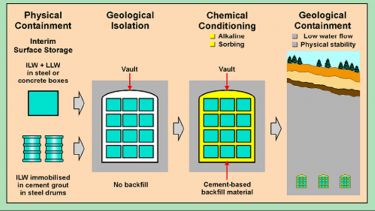BIGRAD: BIogeochemical gradients and RADionuclide transport

This £3M NERC-funded consortium project will undertake experimental laboratory and modelling studies.
The project aims to develop fundamental knowledge and new modelling approaches to predict the chemical, physical and biological development of the alkaline chemically disturbed zone. This zone is the interface between barrier materials and the geosphere in the deep geological disposal facility hosting intermediate-level radioactive waste.
Summary
Intermediate level waste (ILW) is an important component of the UK´s inventory of radioactive waste. ILW consists of metal fuel storage containers, sludges and organic debris produced during the nuclear fuel cycle.
It will be disposed of in a deep geological disposal facility (GDF) that includes encapsulation by cementitious backfill within a multiple barrier system.
Over geological timescales the ILW and its steel containers are planned to degrade, ultimately causing the cement and metal in the GDF to react with the groundwater to make it very alkaline and reducing.
This alkaline water will react with the rock around the repository to form an interface between the GDF and geosphere, the "chemically disturbed zone" (CDZ).
The CDZ is characterised by steep biogeochemical gradients in pH, redox conditions and solute concentrations caused by microbiological and chemical reactions between constituents in the ILW, cement backfill and saturated host rock.
These gradients are critical controls on radionuclide behaviour and transport, and thus on the safety and environmental impact of a GDF. Interactions with organic fractions and colloids in the waste and mineral dissolution and formation of secondary phases within the barrier and host rock matrix will also be important controls on radionuclide speciation, mobility and biogeochemistry within the CDZ.
Experimental studies are needed to deduce the microbiological, geochemical, mineralogical and hydogeological processes that interact to control radionuclide fate and transport over different spatial and temporal scales.
Advanced numerical reactive transport models are needed to translate fundamental understanding of these processes into management tools for prediction of radionuclide behaviour in the CDZ, decisions on GDF design and environmental risk assessment.
Project aims
The aims of the project, integrated within three themed work packages, are to:
- identify the products and phases arising from reaction of high pH fluids with host rock.
- assess the microbial ecology and geomicrobiological processes within the CDZ.
- quantify the effects of reaction between the host rock, high-pH fluids and biogeochemical processes on permeability evolution.
- define the effects of solution components and colloid/mineral surfaces on speciation and mobility of radionuclides.
- define the impact of geomicrobiological processes on radionuclide speciation and mobility.
- define the thermodynamic and kinetic parameters needed to predict radionuclide behaviour.
- develop numerical modelling tools that provide a quantitative description of radionuclide transport. in the CDZ, using experimental results from the lab studies.
- test and interpret the CDZ concept at field-scale using the modelling tools.
Scientific approach
An integrated multidisciplinary programme of experimental laboratory and applied modelling studies will be undertaken to develop fundamental knowledge and new modelling approaches to predict the chemical, physical and biological development of the CDZ under realistic conditions.
The research will focus on the behaviour of four contrasting long-lived radionuclides within the CDZ: technetium, uranium, neptunium and plutonium.
The research team at Sheffield, comprising staff from the GPRG and Cell Mineral Research Centre, will conduct laboratory studies to simulate the development of an alkaline plume produced by the CDZ within a physical model of an aquifer, and develop the advanced modelling tools to interpret the laboratory-scale process studies undertaken by other project teams within the research consortium.
Project partners
- Universities of Manchester, Leeds, Loughborough and Sheffield
- British Geological Survey
- ANKA KIT Synchrotron, Karlsruhe
- UK DIAMOND Synchrotron
- National Nuclear Laboratory
- Nuclear Decommissioning Authority Radioactive Waste Management Directorate
